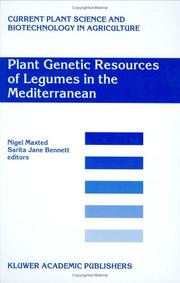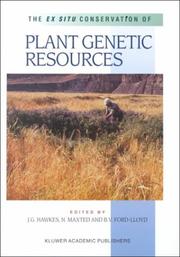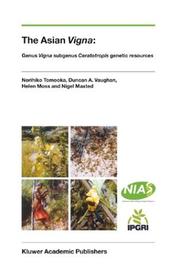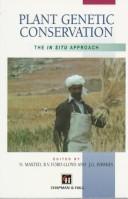| Listing 1 - 6 of 6 |
Sort by
|

ISBN: 0792367073 9048156130 9401598231 Year: 2001 Publisher: Dordrecht : Springer Netherlands : Imprint: Springer,
Abstract | Keywords | Export | Availability | Bookmark
 Loading...
Loading...Choose an application
- Reference Manager
- EndNote
- RefWorks (Direct export to RefWorks)
Genetic erosion, that is, the loss of native plant and genetic diversity has been exponential from the Mediterranean Basin through the Twentieth century. This careless eradication of species and genetic diversity as a result of human activities from a 'hot-spot' of diversity threatens sustainable agriculture and food security for the temperate regions of the world. Since the early 1900s there has been a largely ad hoc movement to halt the loss of plant diversity and enhance its utilisation. The Convention on Biological Diversity and Food and Agriculture Organisation of the United Nations International Undertaking on Plant Genetic Resources, both highlight the need to improve conservation methodologies and enhance utilisation techniques. It has been argued that the most important component of biodiversity is the genetic diversity of crop and forage species used to feed humans and livestock. These cultivated and related wild species provides the raw material for further selection and improvement. Leguminosae species are of major economic importance (peas, chickpeas, lentils and faba beans, as well as numerous forage species) and provide a particularly rich source of protein for human and animal foods. Their distribution is concentrated in the Mediterranean region and therefore the improvement of their conservation and use in the region is critical. This text is designed to help ensure an adequate breadth of legume diversity is conserved and to help maximise the use of that conserved diversity. The subjects of conservation and use of legume diversity, the Mediterranean ecosystem and taxonomy of legumes are introduced. Generic reviews of the taxonomy, centre of diversity, ecogeographic distribution, genetic diversity distribution, conservation status, conservation gaps and future research needs are provided, along with a discussion of the importance of rhizobia to the maintenance of legume diversity. Current ex situ and in situ conservation activities as well current legume uses are reviewed. In conclusion future priorities for ex situ and in situ plant genetic conservation and use of Mediterranean legumes are highlighted. All contributors look forward rather than simply reviewing past and current activities and therefore it is hoped that the identification of genetic erosion, location of taxonomic and genetic diversity and promotion of more efficient utilisation of conserved material will be enhanced.
Cicer --- Lathyrus --- Leguminosae --- Lens --- Lupinus --- Medicago --- Pisum --- Trifolium --- Vicia --- ex situ conservation --- genetic diversity --- in situ conservation --- plant genetic resources --- the Mediterranean ( = region ) --- Plant science. --- Botany. --- Trees. --- Plant systematics. --- Plant taxonomy. --- Plant Sciences. --- Tree Biology. --- Plant Systematics/Taxonomy/Biogeography. --- Botanical classification --- Botanical systematics --- Botanical taxonomy --- Botany --- Classification --- Plant biosystematics --- Plant classification --- Plant systematics --- Plant taxonomy --- Systematic botany --- Systematics (Botany) --- Taxonomy, Plant --- Plant taxonomists --- Dendrology --- Nursery stock --- Woody plants --- Arboriculture --- Forests and forestry --- Timber --- Botanical science --- Phytobiology --- Phytography --- Phytology --- Plant biology --- Plant science --- Biology --- Natural history --- Plants --- Floristic botany
Book
ISBN: 9789290438052 Year: 2009 Publisher: Maccarese : Biodiversity International,
Abstract | Keywords | Export | Availability | Bookmark
 Loading...
Loading...Choose an application
- Reference Manager
- EndNote
- RefWorks (Direct export to RefWorks)

ISBN: 0792364422 9401058059 9401141363 Year: 2000 Publisher: Dordrecht : Kluwer Academic Publishers,
Abstract | Keywords | Export | Availability | Bookmark
 Loading...
Loading...Choose an application
- Reference Manager
- EndNote
- RefWorks (Direct export to RefWorks)
It is a distressing truism that the human race during the last millennium has caused the exponential loss of plant genetic diversity throughout the world. This has had direct and negative economic, political and social consequences for the human race, which at the same time has failed to exploit fully the positive benefits that might result from conserving and exploiting the world's plant genetic resources. However, a strong movement to halt this loss of plant diversity and enhance its utilisation for the benefit of all humanity has been underway since the 1960's (Frankel and Bennett, 1970; Frankel and Hawkes, 1975). This initiative was taken up by the Convention on Biological Diversity (CBD, 1992) that not only expounds the need to conserve biological diversity but links conservation to exploitation and development for the benefit of all. Article 8 of the Convention clearly states the need to develop more effective and efficient guidelines to conserve biological diversity, while Article 9, along with the FAO International Undertaking on Plant Genetic Resources, promotes the adoption of a complementary approach to conservation that incorporates both ex situ and in situ techniques.
Ressource végétale --- Plant resources --- Biodiversité --- Biodiversity --- Plante sauvage --- Wild plants --- Plante de culture --- Crops --- Conservation des ressources --- Resource conservation --- Germplasm --- Pool de gènes --- Gene pools --- Évaluation --- evaluation --- Contexte économique --- economic environment --- Traitement des données --- Data processing --- Analyse de données --- Data analysis --- Étude de cas --- case studies --- Oryza --- Triticum --- Solanum --- Musa --- Coffea --- Trifolium --- Leucaena --- Orchidaceae --- 631.526 --- 502.753 --- 574.472 --- Groups and types of cultivated plants. Genetic resources --- Protection of individual plant species from extinction, extermination --- CON Bioconservation --- bioconservation --- conservation --- ex situ conservation --- genebanks --- nature conservation --- plant genetic resources --- 574.472 Biodiversity --- 502.753 Protection of individual plant species from extinction, extermination --- 631.526 Groups and types of cultivated plants. Genetic resources --- Germplasm resources conservation --- Germplasm resources, Plant --- Conservation of plant genetic resources --- Conservation of plant germplasm resources --- Plant genetic resources --- Plant germplasm resources --- Plants, Cultivated --- Germplasm resources --- Conservation of germplasm resources --- Genetic resources conservation --- Germplasm conservation --- Germplasm resource conservation --- Conservation of natural resources --- evaluation. --- Plant ecology. --- Evolutionary biology. --- Human genetics. --- Plant science. --- Botany. --- Plant Ecology. --- Evolutionary Biology. --- Human Genetics. --- Plant Sciences. --- Botanical science --- Phytobiology --- Phytography --- Phytology --- Plant biology --- Plant science --- Biology --- Natural history --- Plants --- Genetics --- Heredity, Human --- Human biology --- Physical anthropology --- Animal evolution --- Animals --- Biological evolution --- Darwinism --- Evolutionary biology --- Evolutionary science --- Origin of species --- Evolution --- Biological fitness --- Homoplasy --- Natural selection --- Phylogeny --- Botany --- Phytoecology --- Vegetation ecology --- Ecology --- Floristic botany --- Floristic ecology

ISBN: 1402008368 9401039348 9401003149 Year: 2002 Publisher: Dordrecht : Springer Netherlands : Imprint: Springer,
Abstract | Keywords | Export | Availability | Bookmark
 Loading...
Loading...Choose an application
- Reference Manager
- EndNote
- RefWorks (Direct export to RefWorks)
The Asian beans and grams, the species of Vigna (subgenus Ceratotropis), include several legumes that are an essential component in the diets of a large proportion of Asia's population, and interest in these legumes is growing as ethnic cuisine spreads worldwide. However, this important group of legumes is little known compared to the closely related Phaseolus beans and soybean. That deficiency is addressed for the first time in this fully illustrated comprehensive conservation, genetics, taxonomic, and agricultural monograph on the genetic resources of the Asian Vigna. The book deals with the phylogeny of the group from the perspectives of morphological and molecular analyses, ex situ and in situ conservation, eco-geographical analyses, and research. In addition, morphological descriptions, keys, and eco-geographic details of each species in the group are provided. This genetic resources handbook and guide to the Asian Vigna will be a valuable reference for agriculturists, conservationists, taxonomists, other scientists, and students interested in the legumes and plant genetic resources.
Asia --- Fabaceae --- Leguminosae --- Vigna --- genetic resources --- Plant science. --- Botany. --- Nature conservation. --- Plant systematics. --- Plant taxonomy. --- Plant ecology. --- Plant Sciences. --- Nature Conservation. --- Plant Systematics/Taxonomy/Biogeography. --- Plant Ecology. --- Botany --- Phytoecology --- Plants --- Vegetation ecology --- Ecology --- Botanical classification --- Botanical systematics --- Botanical taxonomy --- Classification --- Plant biosystematics --- Plant classification --- Plant systematics --- Plant taxonomy --- Systematic botany --- Systematics (Botany) --- Taxonomy, Plant --- Plant taxonomists --- Conservation of nature --- Nature --- Nature protection --- Protection of nature --- Conservation of natural resources --- Applied ecology --- Conservation biology --- Endangered ecosystems --- Natural areas --- Botanical science --- Phytobiology --- Phytography --- Phytology --- Plant biology --- Plant science --- Biology --- Natural history --- Conservation --- Floristic botany --- Floristic ecology

ISBN: 0412634007 0412637308 9400914377 Year: 1997 Publisher: London : Chapman and Hall,
Abstract | Keywords | Export | Availability | Bookmark
 Loading...
Loading...Choose an application
- Reference Manager
- EndNote
- RefWorks (Direct export to RefWorks)
The recent development of ideas on biodiversity conservation was already being considered almost three-quarters of a century ago for crop plants and the wild species related to them, by the Russian geneticist N.!. Vavilov. He was undoubtedly the first scientist to understand the impor tance for humankind of conserving for utilization the genetic diversity of our ancient crop plants and their wild relatives from their centres of diversity. His collections showed various traits of adaptation to environ mental extremes and biotypes of crop diseases and pests which were unknown to most plant breeders in the first quarter of the twentieth cen tury. Later, in the 1940s-1960s scientists began to realize that the pool of genetic diversity known to Vavilov and his colleagues was beginning to disappear. Through the replacement of the old, primitive and highly diverse land races by uniform modem varieties created by plant breed ers, the crop gene pool was being eroded. The genetic diversity of wild species was equally being threatened by human activities: over-exploita tion, habitat destruction or fragmentation, competition resulting from the introduction of alien species or varieties, changes and intensification of land use, environmental pollution and possible climate change.
574.472 --- 575.17 --- 502.753 --- 574.472 Biodiversity --- Biodiversity --- 502.753 Protection of individual plant species from extinction, extermination --- Protection of individual plant species from extinction, extermination --- 575.17 Population genetics. Genetic processes in populations --- Population genetics. Genetic processes in populations --- plant population --- genetic resources --- Resource conservation --- Germplasm resources, Plant --- Conservation of plant genetic resources --- Conservation of plant germplasm resources --- Plant genetic resources --- Plant germplasm resources --- Plants, Cultivated --- Germplasm resources --- Germplasm resources, Plant. --- Germplasm resources [Plant ] --- Plant ecology. --- Evolutionary biology. --- Human genetics. --- Plant science. --- Botany. --- Plant Ecology. --- Evolutionary Biology. --- Human Genetics. --- Plant Sciences. --- Botanical science --- Phytobiology --- Phytography --- Phytology --- Plant biology --- Plant science --- Biology --- Natural history --- Plants --- Genetics --- Heredity, Human --- Human biology --- Physical anthropology --- Animal evolution --- Animals --- Biological evolution --- Darwinism --- Evolutionary biology --- Evolutionary science --- Origin of species --- Evolution --- Biological fitness --- Homoplasy --- Natural selection --- Phylogeny --- Botany --- Phytoecology --- Vegetation ecology --- Ecology --- Floristic botany --- Floristic ecology --- Crops --- Management. --- Agricultural crops --- Crop plants --- Farm crops --- Industrial crops --- Farm produce --- Agronomy --- Crop science --- Plant products
Book
ISBN: 9290434570 Year: 2000 Publisher: Rome IPGRI
Abstract | Keywords | Export | Availability | Bookmark
 Loading...
Loading...Choose an application
- Reference Manager
- EndNote
- RefWorks (Direct export to RefWorks)
| Listing 1 - 6 of 6 |
Sort by
|

 Search
Search Feedback
Feedback About
About Help
Help News
News